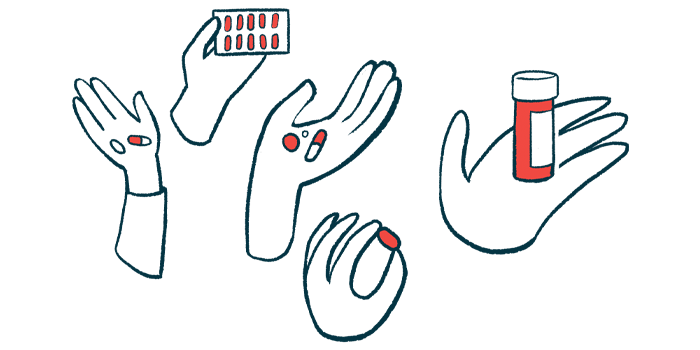Woman’s Cushing’s Symptoms Ease After Thyroid Cancer Treatment
Resolution of hypercortisolism with Retsevmo called 'rapid and long-lasting'

A woman developed Cushing’s syndrome following a medullary thyroid cancer that arose due to a mutation in a gene called RET, but her symptoms eased after starting Retsevmo (selpercatinib), a cancer medication, according to a report from France.
The report, “Rapid and long-lasting response to selpercatinib of paraneoplastic Cushing’s syndrome in medullary thyroid carcinoma,” was published in the European Thyroid Journal.
Medullary thyroid cancer is the rarest type of cancer in the thyroid, a gland located in the front of the neck. About one in four cases of medullary thyroid cancer run in families as a result of a mutation in the RET gene that’s passed down from parents to their children.
Some patients don’t have a family history of the disease, but may carry a spontaneous (newly occurring) mutation in the RET gene, which provides instructions for making a protein involved in communication within cells A mutation may kick off the production of proteins that cause cancer to grow.
Retsevmo, sold as Retevmo in the U.S., is a cancer medication used by patients whose cancer is caused by a mutation in the RET gene. It works by turning off the production of mutated RET. This helps shrink tumors and prevent cancer cells from spreading to other parts of the body.
Like other types of cancer, medullary thyroid cancer releases substances that meddle in how other cells and tissues in the body work. Sometimes, it releases adrenocorticotropic hormone (ACTH), which drives the adrenal glands atop the kidneys to produce cortisol.
The release of ACTH from medullary thyroid cancer may cause Cushing’s syndrome, which happens when the body has an excess of cortisol. Cortisol is a hormone involved in many functions, from helping the body cope with stress to keeping inflammation down and controlling blood pressure and sugar levels. When there is too much cortisol, a wide range of symptoms can occur.
Hypercortisolism following cancer surgery
Researchers in France presented the case of a woman who went to the hospital with symptoms of Cushing’s syndrome about 14 years after she was diagnosed with medullary thyroid cancer. She had no family history of the disease.
The woman had undergone a complete thyroidectomy (a surgery to remove the thyroid gland) and radiotherapy to treat metastases, or cancer that had spread to the liver and bones.
She also developed a type of breast cancer that was treated with surgery, chemotherapy, and Arimidex (anastrozole) to block the production of the hormone estrogen and help stop the cancer from growing or spreading.
While she was having bone pain and chronic diarrhea (loose or watery stools that persisted for years), the woman refused Caprelsa (vandetanib), a cancer medication, fearing potential heart-related side effects.
When she went to the hospital with Cushing’s symptoms, she had an ECOG performance status of 2, meaning she was able to walk and take care of herself, but was unable to work.
A physical examination revealed a lack of energy and strength, a buildup of fat around the face (moon face), weak muscles, and fragile skin — all symptoms of hypercortisolism, or too much cortisol in the body. She also continued to have diarrhea caused by an excess of calcitonin, a hormone made by the thyroid gland.
A sample of tissue taken from the lymph nodes above the collarbone showed the medullary thyroid cancer had spread there and genetic testing revealed a mutation, called c.2753T>C, in the RET gene.
Since the woman was deemed unfit for surgery to remove the adrenal glands, she had a procedure called embolization to block the release of cortisol from the right adrenal gland. She refused embolization of the left adrenal gland.
Lowering cortisol levels
Symptoms of hypercortisolism persisted, however, and she was started on ketoconazole, an antifungal medication (sold as Nizoral, among other names) that lowers cortisol levels and may be a good treatment choice for Cushing’s syndrome when surgery is not an option.
After a month on ketoconazole, she was switched to Retsevmo. The initial dose should have been 160 mg twice daily, “but the patient misunderstood and took only half of the dose” for three months, the researchers wrote.
Despite the lower dose, “clinical efficacy was immediate,” the researchers wrote. Her diarrhea and hypercortisolism symptoms resolved in just a few days.
Her urine cortisol levels, which were 298 micrograms in the 24 hours (six times the upper limit of the normal range) before treatment with Retsevmo, dropped to 42 micrograms in 24 hours after two months. Levels of calcitonin and CEA, a cancer biomarker, also dropped.
A few months after being on 160 mg twice daily, the dose was reduced to 120 mg twice daily due to side effects (fatigue). With the lower dose, she experienced mild headache, meaning she tolerated it well.
Imaging tests showed a reduction in the number and size of metastases in the lungs, liver, and lymph nodes, while those in the bones remained stable.
The response to Retsevmo was “rapid and long-lasting,” paving the way toward its use as first-line treatment. The team noted this case underscores “the potential benefit of molecular [genetic] testing in all cases of medullary thyroid cancer.”








